SONOS Speakers. (Source: http://blog.sonos.com/en/listening-to-vinyl-with-sonos/)
New smart home products are being introduced at an increasingly rapid pace. Whether you choose to introduce them into your home or not, the movement is picking up steam, yet it still feels like the wild west. While leaders have begun to emerge, opportunity abounds as very few brands seem to have identified just what makes a superior smart home device. In this article, we discuss five traits of successful smart home devices, identified through working with leading smart home brands.
First, let’s define what is meant by the term “smart home device”. This is easier said than done, because as technology evolves, new possibilities are unleashed, subjecting the term to new interpretations (see 3D printed objects connect to WiFi without electricity). At the most basic level, a smart home device is an appliance with enhanced functionality made possible by one or more of the following characteristics:
- A connection to the internet
- A connection to another device (like your smartphone)
- Onboard sensor(s) that collect information
Defining exactly what “enhanced functionality” entitles is also up for debate. Many device manufacturers have tried slapping the “smart” label on devices, resulting in dumb user experiences. For example, the most frequent “smart, but not smart” feature is adding smartphone control to a device for no practical reason (other than as a marketing gimmick). For the purpose of this article, we will settle on enhanced functionality as providing an increased level of convenience, control, or cost-savings over the device’s non-smart equivalent.
What makes a superior smart home device? While the parameters of a successful smart home device differ across categories and according to the needs of the intended user, some hold true in all contexts. Over the course of collaborating with leading consumer brands like Philips, Legrand, and SONOS, Essential has identified core traits that repeatedly show up in successful smart home products. Some of these traits apply to the broad discipline of product design, while others are particularly essential within the smart home.
1. Easy Enjoyable to setup
The first and often the most telling trait of a smart home device is the setup experience. The onramp into your product’s experience begins before your customers even receive the product. Whether online or in-store, this is where people form their initial impressions of your product and your company- this is where a foundation of trust begins. Even the opening of the packaging itself, which is referred to as the “unboxing” experience, (a sub-segment of the out-of-box experience) must be given careful attention. For example, Apple and SONOS have both been praised for the way the upper lid of their boxes glides off the bottom of the box with carefully calibrated intention. It may sound over the top, but it isn’t, not if you want to create superior product experiences.
The setup experience for smart devices is simple in theory, but whether delightful moments or annoying hiccups, small details can add up and either elevate the product or derail even the smartest intentions. Brands that treat setup with just as much attention to detail as the rest of their product consistently see higher sales performance. For example, Nest understood that getting consumers of various skill levels to replace their own thermostats was going to be a barrier. To combat this, Nest examined the thermostat replacement process at a fine level of detail, going as far as to provide a beautifully designed screwdriver in the box- not as a freebie, but because it made the process more smooth, everything you need is right in the box. SONOS, another leader in the connected home space, realized that the process of setting up a network of wireless speakers in your home could go horribly wrong. From their start, SONOS has been lauded for their effortless app-powered set up experience. Specifically, what makes the experience so easy is that the app can discern whether you have successfully completed a step, or if you might be struggling, in which case it offers a suggestion (which usually works). The bottom line is to not treat setup as an after thought; it might be the only thought your smart product is ever given before being returned to the store.
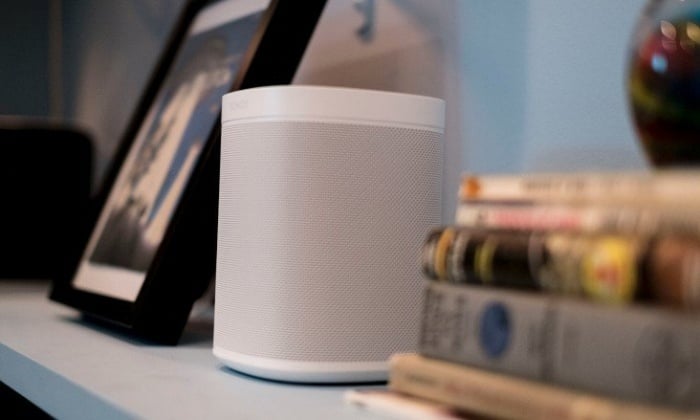
SONOS Speaker. (Source: https://www.sonos.com/en-us/shop/one.html)
2. Solve a problem, without creating others
We don’t need smart home devices to survive. Additionally, smart devices, and the data that they perpetually collect about the people using them, can be off putting and downright scary for some people (stay-tuned for an upcoming Essential perspective on how to design connected products that address data privacy and other concerns of users.) Nevertheless, we choose to bring devices into our lives and into our homes when they promise to solve a problem, regardless of the size of that problem, whether it is making a piece of our lives smoother, safer, more enjoyable, or to save us time/money. Understanding the people who will interact with your product and what they truly value in a given context inspires new creations and brings focus to the design process.
One example of solving one problem without creating others may seem obvious, yet many companies gloss over it: strong wireless connectivity. Most smart home appliances have some form of wireless connection (e.g. Bluetooth, zigbee, wi-fi, mesh, cellular, etc.). When a device’s wireless connection isn’t bulletproof, devices can become infuriatingly disconnected and require troubleshooting. Excellent connectivity can itself be a competitive differentiator, an attribute that Sonos is well known for.
Another example of not creating other problems is perfectly illustrated by Philips Hue, a pioneer in smart homes. When Phillips set out to create a light switch for their Hue light bulbs, they apparently learned that many people (especially renters) would not feel inclined to replace and re-wire a light switch, even if the new switch provided special capabilities (e.g. custom lighting scenes). They also discovered that in some instances, changing a battery on a non-hardwired switch might also be undesirable. To work within these constraints, Philips created the Hue Tap Switch, a wireless and battery-less puck sized light switch. The switch contains a tiny energy harvesting mechanism that converts the physical motion of your button press into a tiny wireless signal powerful enough to tell your lights to turn on. No wires, no battery changing, just stick the switch onto your wall and press a button.
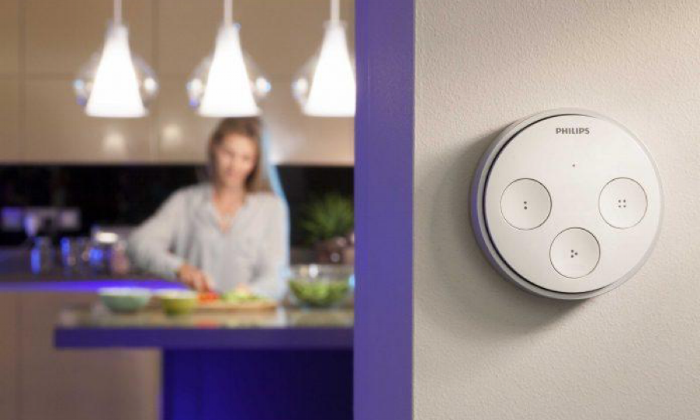
Philips Hue Tap Switch. (Source: https://www2.meethue.com/en-us/p/hue-tap-switch/046677456696)
3. Goal-oriented design
It is important to remember that the purpose of interacting with any device is not for the sake of the interaction itself, but to achieve a desired state or emotion. This becomes very apparent when manufacturers insist on relying on smartphone control as the primary means of engagement, thinking “smartphone control = innovation”. That approach stopped working years ago for a variety of reasons related to unanswered questions. Does the device benefit from an external software-based control? Is remote control applicable/useful? Does the tracking or quantification of data help your customers, or is the data for you (the manufacturer) and other stakeholders? Another issue with smartphone-controlled smart home devices is that you must have your phone on you. If direct phone-interaction is required (as opposed to something like geo-fencing), it can take a concerted effort to locate your phone, clean off your hands, unlock your phone, navigate to the app or widget, wait for it to open and finally activate the feature you were looking to use in the first place. This becomes even more complicated when performing a task that relies on multiple smart devices, for example pausing the music and dimming the lights so you can enjoy your favorite TV show. How can designers support goals and end states more efficiently? Designers at Logitech saw smartphone-control as a pain point, and created a product specifically in response to it. They invented the POP Smart Button- a wireless, convenient control for your smart home. You set the POP to respond to 1, 2 or 3 presses, triggering your smart gadgets to perform common tasks solo or in unison. So now getting more done really could be as easy as pushing a button.

POP Smart Button. (Source:http://support.logitech.com/en_us/product/pop-smart-button)
Now “Control it with your voice!” is the new “Control it with an app!” As we could see from the product announcements at this year’s Consumer Electronics Show in Las Vegas, voice control is going mainstream. Amazon’s Alexa voice technology (and Google’s) has made it’s way out of Amazon’s own cylindrical speaker and into phones, cars, refrigerators, and most recently into the bathroom (virtually every major speaker manufacturer now offers Alexa integration). Voice control holds a lot of promise, but just like smartphone control, it needs to be applied correctly, efficiently, and with purpose. What other ways can we interact with devices without depending on our phones?
4. Blend in…or stand out
If Amazon is any example, a smart home product doesn’t need to be an object of beauty to be successful. The original Echo wasn’t lauded for its dashing looks- standing awkwardly on furniture with blue and green lights broadcasting its presence, yet Amazon sold millions of Echos before recently updating the design cloaking the device in a softer, more friendly fabric exterior suitable for more homes. When Echo isn’t lit up, at least the matte black (or white) surface doesn’t call too much attention to itself. Smart home devices should blend into their surroundings (caveat, there is a time and place to make a statement with striking industrial design). Leading device manufacturers are using both form and color/material/finish (CMF) to achieve a stealthy presence. Of course, what works with American traditional décor may not work as well in a more modern setting and vice versa- the mass market is only just starting to pay more attention to this in regards to devices. *Shameless self-promotion alert* Essential has worked with leading consumer appliance brands to conduct research in people’s homes in an effort to define and understand the makeup of various styles and the motivations that drive those choices (also see our work with Altec Lansing for example). If offering a variety of SKUs in different CMF isn’t realistic, aim for keeping it simple and timeless. Today, the primary colors of choice are most often white or grey- but there is certainly room to have fun with color in certain applications. Some brands are better served by a design that doesn’t try to blend in but rather functions as means of self-expression.
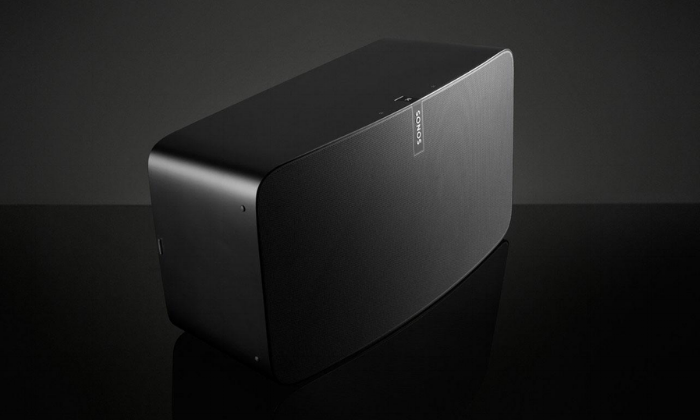
SONOS’s PLAY:5. (Source:https://www.sonos.com/en-us/shop/play5.html)
As we see smart home interfaces shift from glossy black screens towards, subtler, softer, and more ambient UIs that may not even have a screen at all, it is more important than ever to consider interface design. A prime example is the touch-based interface found on SONOS’s PLAY:5 and PLAYBASE speakers, for which Essential provided human factors research. Rather than rely on three-dimensional buttons or a screen, SONOS blended the controls directly into the speaker’s housing using capacitive touch, resulting in a subtle and fluid form as well as the ability to support a more dynamic interface. Another example is Nest’s new Thermostat E. In designing the E, Nest eschewed the brushed stainless steel ring and glossy black screen that put them on the map, opting instead for a monochrome white design with a soft, frosted white screen and a primarily white software UI. The result is a product that doesn’t overtly look like a device until you walk up to it and it lights up. Lighting and interface elements should not call attention to the device when the device is not needed, an exception might be a subtle indicator to communicate system status/errors at a glance. The above begs the question, what does it mean to look like a device?
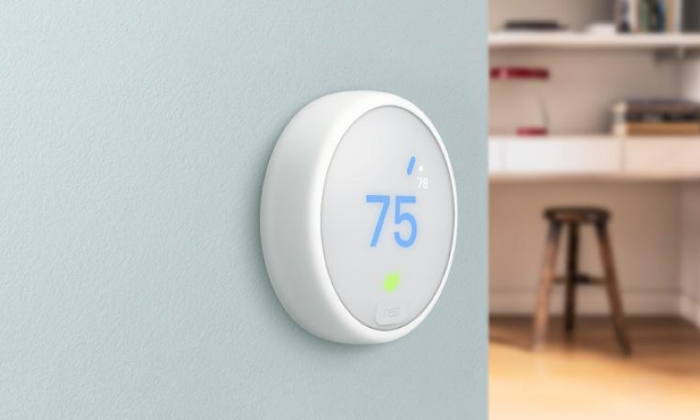
Nest’s new Thermostat E. (Source:https://nest.com/connected-home/energy/the-technology-behind-the-nest-thermostat-e-s-display)
5. Play nicely with others
The smart home space is still in its infancy, with multiple competing platforms and no clear leader. This means that consumers need a base level of understanding of which products are compatible with others. Each app we download, each service we sign up for, and every gadget we buy carries a maintenance cost with it. Perhaps more important than the monetary cost is the time it takes to learn about the device, as well as use and maintain it. Buying into one platform, say Apple’s HomeKit, opens up one world of compatible devices and services that you can use, while Amazon Alexa offers a different, occasionally overlapping world. It can get messy (and costly), even if you know what you are doing. All of this confusion and cost can lead to decision paralysis and frustration among the tech-forward people that are most likely to buy your products.
So should manufacturers and developers embrace all of the platforms? For now, it appears to be the safest move, even though it can be a bear to get authorized on all the major platforms and to develop support for each. For smaller players, it may make more sense to focus on the platform that your target market is most likely to use, and focus on nailing that experience before expanding with either new products or new platform compatibility. One of the earliest pioneers in this space, Belkin, whose Wemo line of products has been extremely successful, realized that not being compatible with Apple HomeKit was preventing some people from buying into their platform (Belkin and Apple have grown together over the years). Because HomeKit compatibility requires certain hardware bits to be in the product, Belkin couldn’t just push a software update to instantly make their products compatible, they had to design and manufacture an entirely new product to make their current portfolio compatible, which they just did at CES.
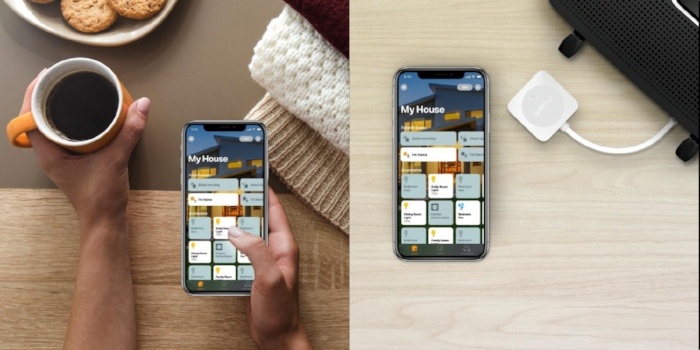
Philips Hue Tap Switch. (Source:https://9to5mac.com/2018/01/08/buy-belkin-wemo-homekit-bridgeBelkin_/)
As discussed above, these are still early days for the smart home, and as such the five traits listed are rarely ever achieved by any one product. And as these traits do get baked into the design of future smart home devices, next level usability needs can be considered.
For more information on Connected Products at Essential Design, click here.
_______________________________________________________________________
Paul Naddaff is a Senior Researcher in Innovation Strategy at Essential Design.
Essential Design is a leading Innovation Strategy & Design consultancy. We work across the healthcare, consumer, and commercial industries, helping our clients conceive and drive to market comprehensive digital, physical, and service experiences.


